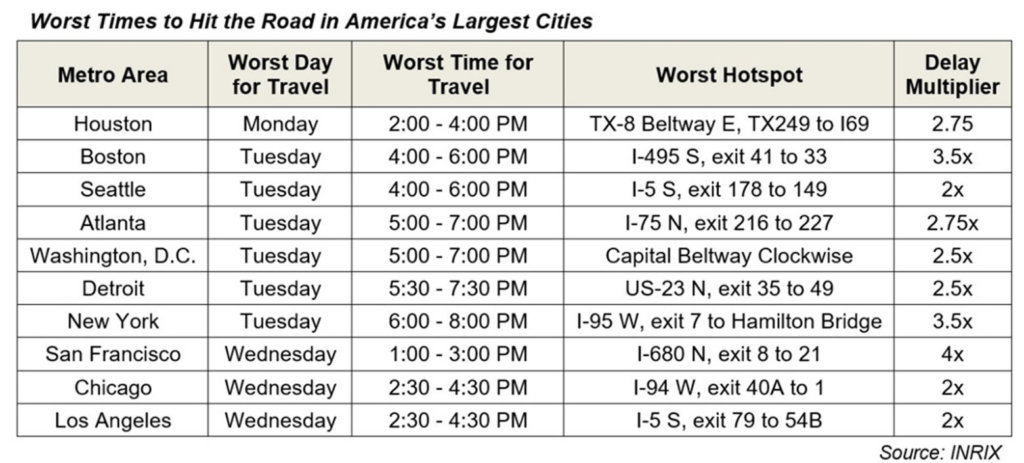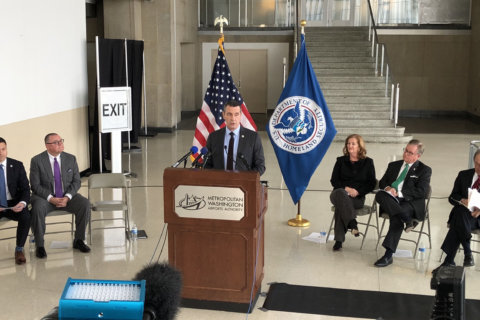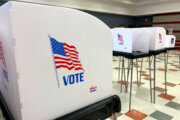WASHINGTON — If you crack the wishbone this Thanksgiving, consider praying for lighter traffic: AAA Mid-Atlantic forecasts that 1.3 million people living in and around the D.C. region this year will be traveling.
That’s the most since 2005. And it means travel times could be four times longer over the holiday week.
According to a news release, two out of every 10 residents of the Washington area, which boasted a 2017 populace of 6,216,589 strong, will travel more than 50 miles to celebrate Thanksgiving with friends and family this year.
Nationwide, 54.3 million are projected to head home for the holiday.
Even though gas prices will be at their highest in four years (the national average is $2.69 a gallon as of Nov. 13), driving remains the preferred mode of transportation for nine in ten Americans, or 48.5 million Thanksgiving travelers, the news release said.
“Historically, the Wednesday before Thanksgiving, and the Sunday after the holiday, were the worst days to travel during the busy holiday period,” said John B. Townsend II, AAA Mid-Atlantic’s manager of public and government affairs.
“Now it is shifting, as everyone tries to get a head start on the holiday, and a jump on millions of other holiday travelers heading for the exits. While the Wednesday before Thanksgiving is still the busiest day to fly, Tuesday is now the worst day and time to hit the highways for the holiday,” Townsend said.
AAA says, 3.9 million people living in Virginia, Maryland and D.C. will travel more than 50 miles during the Thanksgiving holiday. And 3.6 million of them are estimated to hit the highways.
The worst time to travel in the D.C. area? AAA says that dubious honor goes to the Tuesday before Thanksgiving from 5 p.m. to 7 p.m. Delays are expected to be at least two and a half times worse than usual.
“Thanksgiving is one of the busiest holidays for road trips, and this year will be no different,” said Trevor Reed, transportation analyst at analytics firm INRIX.
“Knowing when and where congestion will build can help drivers avoid the stress of sitting in traffic. Our advice to drivers is to avoid commuting times in major cities altogether or plan alternative routes.”

- By road: A projected 1,206,100 Washington metro residents plan to travel to their Thanksgiving holiday destinations by automobiles, an increase of 4.8 percent from the 1,151,100 area residents who traveled by automobile over the Thanksgiving holiday in 2017. Travel by automobile is the planned mode of travel for 91 percent of Washington metro area travelers.
- By air: A projected 95,500 Washington area residents plan to fly to their Thanksgiving holiday destinations, which is an increase of 4.6 percent over the 91,300 people who flew in 2017. Air travel is the planned mode of travel for 7 percent of travelers.
- Other: The number of local residents traveling by trains, buses and other modes of transportation is forecast to increase by 0.9 percent to 25,700 persons in comparison to 25,500 in 2017.

“Consumers have a lot to be thankful for this holiday season: higher wages, more disposable income and rising levels of household wealth,” Bill Sutherland, AAA Travel senior vice president, said.
“This is translating into more travelers kicking off the holiday season with a Thanksgiving getaway, building on a positive year for the travel industry.”
Here’s AAA’s national forecast:

- Automobiles: The vast majority of travelers – 48.5 million – will hit the road this Thanksgiving, nearly 5 percent more than last year.
- Planes: The largest growth in holiday travel is by air, at 5.4 percent, with 4.27 million travelers.
- Trains, buses and cruise ships: Travel across these sectors will increase by 1.4 percent, with a total 1.48 million passengers.







